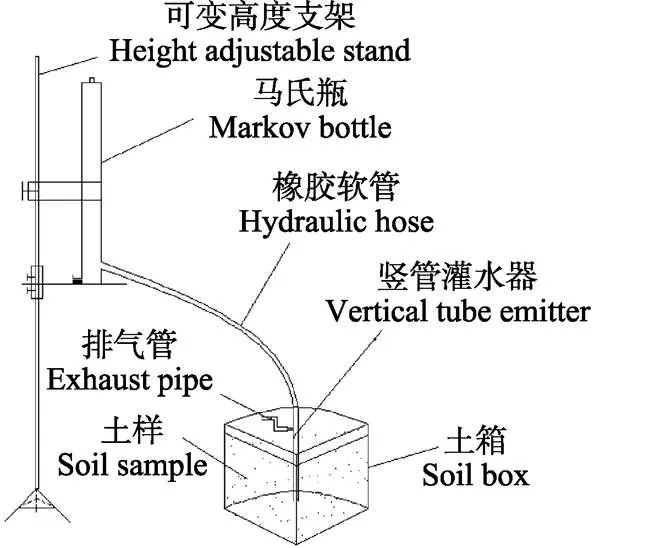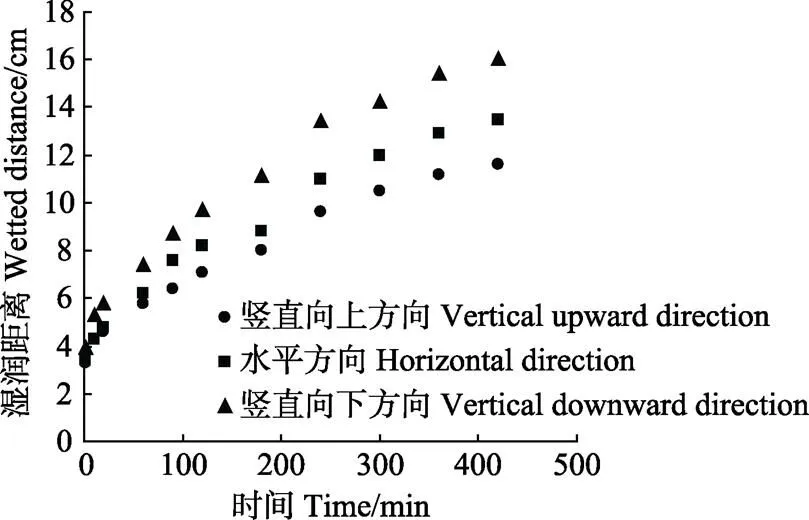地下灌竖管灌水器湿润体时空变化规律
2018-04-11孙淑贞任培琦徐先伯梁志栋
白 丹,孙淑贞,任培琦,徐先伯,梁志栋
地下灌竖管灌水器湿润体时空变化规律
白 丹,孙淑贞,任培琦,徐先伯,梁志栋
(西安理工大学水利水电学院,西安 710048)
研究地下竖管灌水器的土壤湿润体特性时空变化规律及影响因素,对进一步研究竖管地下灌溉技术要素,并将这一节水灌溉技术用于实际具有重要意义。该文基于室内竖管灌水器入渗试验,研究了土壤物理特性参数(土壤初始含水率和土壤容重)、竖管灌水器工作压力水头和灌水器技术参数(竖管管径)对土壤湿润体空间分布的影响。根据试验数据,构建了在不同方向上竖管灌水器工作压力水头、土壤初始含水率、土壤容重、竖管灌水器直径和竖管灌水器埋深等因素与湿润体时空变化特征值的量化关系,其决定系数均在0.85以上。按标准化回归系数分析得湿润锋运移距离与压力水头、初始含水率、竖管直径及竖管埋深呈正相关,与土壤容重呈负相关。湿润锋在各个方向的运移距离由大到小依次为:向下、水平和向上。根据不同方向湿润锋运移距离和各影响因素的量化关系,建立了不同方向湿润锋运移速率和各影响因素的量化关系,这一关系表明:在入渗初期,各个方向的湿润锋运移速率较大,随着入渗时间的延续,其值逐渐减小,在200 min左右,开始逐步趋于稳定。
含水率;土壤;灌水器;地下灌溉;湿润体;运移距离;运移速率
0 引 言
地下灌溉是一种高效节水灌溉方法[1],灌溉水通过埋入地下的灌水器渗入作物周围根系土壤中,其对土壤结构的破坏性小,并能有效地减少土壤表面的水分蒸发损失,节水增产效果十分显著。研究地下灌溉土壤湿润体时空变化特征对地下灌溉灌水器的合理布置具有重要意义,国内外学者在这一领域开展了大量的研究,主要集中在地下滴灌湿润体形状、湿润体含水率分布[2-6]、湿润体特征值变化规律[7-10]及各种影响因素[11]分析等方面。近年来针对学者提出的一些新的地下灌溉技术,开展了陶土头灌水器地下灌溉[12-13]、微润灌溉[14]和无压灌溉[15]等湿润体时空变化规律的研究,为这些新型地下灌溉技术推广应用提供了依据。湿润体形状及大小决定着作物的生长情况以及田间水分利用率。目前对湿润体特性的研究集中在分析湿润锋运移与入渗时间、流量、压力水头、容重和土壤初始含水率等关系方面[16-22],对于各影响因素与湿润锋运移距离的量化关系研究较少。目前地下灌溉应用中要解决的问题之一是如何合理确定灌水器流量、间距、埋深[17,23-26]等参数,而确定这些参数的重要依据是确定土壤湿润体形状、大小及含水率分布。
竖管灌水器是一种新型地下灌溉灌水器,对竖管灌水器入渗过程研究[27-29]表明:土壤质地越重,入渗量越小。入渗条件相同时,砂质壤土入渗量大于粉质壤土。压力水头和管径的大小对累计入渗量影响较大,随入渗时间延长,压力水头和管径对累计入渗量影响程度均减弱;在压力势、重力势和基质势的共同作用下,可根据土壤含水率,自动调节竖管灌水器向土壤入渗的流量,具有自适应灌溉技术的特征;对竖管灌水器入渗结束后的湿润体进行了初步研究[28]表明:湿润体含水率的分布在水平方向呈现为圆环形湿润锋,垂直方向正向减小略慢于负向,湿润半径大小依次为负向湿润距离最大,正向湿润距离最小,水平湿润距离居中;且竖管地下灌溉湿润体的平均含水率变化范围大于微润灌溉。上述成果仅研究了竖管灌水器入渗结束后湿润体含水率分布特征。为了合理的设计竖管地下灌溉系统、提高灌溉水利用率,本文根据地下灌溉灌水器入渗过程中湿润体的时空变化规律和作物根系的分布特征,确定合理的竖管灌水器技术参数(竖管灌水器压力水头、土壤容重、土壤初始含水率、竖管直径和竖管(水土结合面)埋深等),探讨竖管灌水器的技术参数与入渗过程中土壤湿润体时空变化的关系。
1 材料与方法
1.1 供试土壤与试验装置
试验所使用土样取自杨凌,供试土壤经风干、碾碎、均匀混合后过2 mm的筛子,采用Mastersizer 2000激光粒度分析仪(英国马尔文公司)测定土壤粒径组成,其黏粒所占体积分数为18.7%,粉粒为34.7%,砂粒为45.6%,依据国际制土壤分类标准,该土壤质地为黏壤土。
试验装置如图1所示,其由土箱、供水装置和竖管灌水器等组成。试验土箱是一个半径20 cm的1/4圆柱有机玻璃土箱,供水装置采用马氏瓶供水(马氏瓶尺寸为内径为5 cm,高度50 cm)。试验土箱中竖管灌水器和马氏瓶由橡胶管连接,通过调节可变高度的铁架高度来调节竖管压力水头。实际工程中竖管灌水器[15]是一个埋在土壤中与毛管相接的竖管,其上端和毛管相接,下端和土壤接触,水土结合面直径为竖管直径,水土结合面深度为竖管埋深。

图1 地下灌溉竖管灌水器试验装置图
1.2 试验设计


表1 试验设计
1.3 试验方法和观测内容
将试验土按照表1配制不同含水率,按照所定容重分层(5 cm)装入有机玻璃土箱中,层间打毛,使两层土紧密结合。在装土20 cm后开始埋入竖管灌水器,埋深按照表1设置的不同深度装入土箱中。入渗开始后,用秒表计时,并定时观测记录土壤湿润锋在3个方向(水平、向上和向下方向)上的运移距离,得到在不同时刻所对应的湿润体形状。由马氏瓶上的刻度记录渗入土壤中的水量。上述试验在西北旱区生态水利工程国家重点实验室培育基地的室内试验室(西安理工大学)进行。
2 结果与分析
2.1 湿润体形状
为了比较不同影响因素条件下得到的湿润体大小及其形状,由于试验组数较多选取具有代表性的3组试验(试验1、3和5)进行说明,图2分别为试验1、3和5湿润体随时间的变化过程,湿润体形状近似于一个椭球体,出水口位置位于纵坐标原点,对比试验1、3和5湿润体,试验因素值不同,湿润范围也有所不同,表明各影响因素对湿润锋运移影响大小不一。在灌水前期,3个方向上的湿润距离基本一致,湿润体呈圆形,随入渗时间增加,垂直向下方向湿润距离逐渐大于水平和垂直向上方向。土壤湿润体的大小由水平入渗距离和垂直入渗距离2个要素共同决定,水平运移距离和垂直运移距离是湿润体的2个重要特征。掌握湿润体的形状及大小变化规律,可以正确指导在实际工程中合理的布置竖管灌水器。
在不同试验处理下,水平、垂直向上和垂直向下3个方向上湿润锋运移距离随入渗时间的变化如图3所示。结合图3中数据可以看出,土壤湿润变化范围在6.7~19.1 cm之间。以试验10为例,绘制在3个方向上湿润锋运移距离随时间的变化关系图,如图4所示。由图3和图4可知,土壤湿润体在水平方向、垂直向上和垂直向下方向的湿润距离均随入渗时间的增加而增大。在灌水开始,3个方向的湿润距离基本上保持一致,随灌水时间延长,垂直向下方向的湿润距离明显大于其他2个方向。这由于入渗初期土壤水分的运移驱动力主要是基质势,受重力作用较小,而此时灌水器周围基质势基本一样,随着水分的不断入渗,土壤基质势梯度不断减小,此时入渗过程中灌溉水受基质势、压力势和重力势的共同作用,基质势的作用逐渐减小,压力势和重力势影响逐渐增大。随着入渗时间的不断增大,土壤含水率饱和圈增大,水分向周围土壤的扩散速度逐渐减小,最终趋于一个稳定值[19]。
2.2 土壤湿润体与各影响因素之间的关系
2.2.1 湿润锋运移距离经验公式
假设各个方向湿润锋运移距离与各影响因素(包括入渗时间)函数关系如下:


注:湿润锋等高线由里向外表示1、10、20、60、90、120、150、180、240、300、360、420 min的湿润锋。
Note: Contour line from inside to outside represents wetting front at 1, 10, 20, 60, 90, 120, 150, 180, 240, 300, 360 and 420 min, respectively.
图2 湿润锋随时间的变化过程
Fig.2 Changing process of wetting front with time

图3 湿润锋运移距离随时间变化过程

图4 试验10湿润距离随时间变化过程

式中,1和2分别表示水平方向,垂直向上方向,垂直向下方向湿润锋运移距离,cm;为竖管工作压力水头,m;为土壤容重,g/cm3;为土壤初始含水率,%;为竖管直径,mm;为竖管埋深cm:1,1,1,1,1,1,1,2,2,2,2,2,2,2,3,3,3,3,3,3,3均为经验参数。
将第1~18组试验所得的不同时间不同方向的湿润距离与各试验因素数值采用多元回归分析,得到不同方向上各经验参数计算值,将得出的经验值代入式(1)、(2)和(3)中得到式(4)、(5)和(6),经回归分析得垂直向上方向上的决定系数2为0.85(<0.05),均方根误差(root-mean-square error,RMSE)为0.24 cm,水平方向2为0.86(<0.05),RMSE为0.23 cm和垂直向下方向2为0.87(<0.05),RMSE为0.22 cm,表明该量化关系式可以较好地反映竖管灌水器湿润体运移距离与各影响因素间的量化关系。



2.2.2 湿润锋运移经验公式验证
为验证不同方向湿润距离与各因素间的量化关系,用第19组试验数据验证湿润锋运移经验公式,将第19组有关数据(见表1)代入式(4)、(5)和(6),可计算其湿润距离预测值见图5,水平、向上、向下3个方向实测与预测值2分别为0.98、0.99、0.99(<0.05),RMSE分别为0.13、0.05、0.09 cm。说明所建立的量化关系式能较好地反映湿润体运移距离与各影响因素的量化关系。
2.2.3 各影响因素对湿润锋运移距离的影响
根据试验数据(见图3),采用SPSS统计软件,分别计算3个方向上影响湿润锋运移距离的各因素的标准化回归系数(见表2)。表2中,每一方向上各影响因素的标准化回归系数可反映该因素对湿润锋运移距离的影响程度,比较同一方向上各影响因素对应的标准化回归系数绝对值,水平方向各因素影响程度从大到小依次为:入渗时间>压力水头>土壤容重>土壤初始含水率>竖管埋深>竖管直径。垂直向上方向各因素影响程度从大到小依次为:入渗时间>压力水头>土壤容重>竖管埋深> 土壤初始含水率>竖管直径。垂直向下方向各因素影响程度从大到小依次为:入渗时间>压力水头>土壤容重>土壤初始含水率> 竖管埋深>竖管直径。从表2数据中可看出在3个方向上土壤初始含水率差异较为显著,垂直向下方向土壤初始含水率对应的标准化回归系数大于其他2个方向,这主要由于在入渗前期主要受土壤基质势作用,当土壤含水率增大,重力势的作用相对于基质势增大,重力势使得土壤水分垂向入渗总势能大于相同条件下的径向水分入渗的总势能,更有利于湿润峰的垂向前进。在3个方向上均呈现入渗时间、压力水头和土壤容重对湿润锋运移距离的影响较为显著。压力水头、竖管直径、土壤初始含水率和竖管埋深参数的标准化回归系数为正值,表明其与湿润锋运移距离为正相关,即当、、和增大时,湿润锋运移距离增大;土壤容重参数的标准化回归系数为负值,表明其与湿润距离为负相关,即当增大时,湿润锋运移距离减小。

图5 试验预测值与实测值的关系

表2 标准化回归系数
压力水头、竖管管径和竖管埋深均为竖管灌水器技术参数,这3个因素对湿润体的特征参数的影响各不相同。灌水器工作压力水头、土壤的初始含水率、竖管埋深和竖管灌水器直径增大时,湿润体越大;灌水器埋深直接影响作物根系对土壤水分、养分的吸收[26],是土壤湿润体与作物根系有效匹配关键因素, 从而影响植物整体的生长发育,埋深越大,湿润体越大;湿润体体积及湿润锋运移距离随初始含水率增大而增大,主要是与土壤水分的入渗能力等有关,通常初始含水率越小,基质势越大,所产生的基质势梯度也越大,土壤水分运动也就越快[19];土壤容重是反映土壤紧密程度的一个重要指标[22],容重小的土壤,大孔隙多,入渗能力大,其湿润锋运移距离越大。由于土壤水分在垂直方向上受重力作用,水分向下的入渗梯度加大,使得在垂直方向水土结合面以下的湿润距离大于水土结合面以上的湿润距离。在确定竖管灌水器技术参数时,应首先根据作物根系在土壤中的分布,确定湿润体的影响范围,再根据作物根系分布与湿润体影响范围的关系,合理确定竖管灌水器技术参数,以保证土壤中的水分能充分被作物根系吸收,并尽量减少土壤表面蒸发。
2.2.4 湿润锋运移速率
湿润锋运移速率可反映湿润锋运移距离随时间变化快慢的程度。在式(4)、(5)和(6)中,对时间求导,得到3个方向上湿润锋运移速率:



式中分别表示水平方向,垂直向上方向,垂直向下方向湿润锋运移速率,cm/min。
根据建立的各因素之间的量化关系式,以试验19验证,将试验19中各试验因素数值(见表1)代入式(7)、(8)和(9)中,计算可得到预测湿润锋运移速率,绘制实测湿润锋运移速率与预测湿润锋运移速率关系如图6所示。

图6 湿润锋运移速率与时间关系
由图6可以看出湿润锋运移速率在灌水开始较大,随着入渗时间的增大逐渐减小,在入渗开始200 min左右,入渗逐渐趋于稳定。由于在入渗的开始阶段,土壤湿润体体积很小,基质势梯度较高,湿润峰的推进速率较快;随着入渗时间的延长,湿润体体积不断增加,基质势梯度明显降低,导致湿润峰的推进速率随着入渗时间的延长在逐渐的变小,即入渗距离增加的幅度不断减小。在灌水初期,土壤含水率较低,土壤水分扩散为非饱和入渗[31];随着水分的不断入渗,水土结合面周围的土壤含水率逐渐增大,在水土结合面周围土壤含水率趋于饱和,在该过程中灌溉水受基质势、压力势和重力势的共同作用,基质势的作用逐渐减小,压力势和重力势的影响逐渐增大。
3 结 论
本研究表明,各试验因素对地下灌竖管灌水器湿润体大小和形状都有不同程度的影响。在3个方向上湿润锋运移距离变化范围在6.7~19.1 cm之间,其湿润范围较大,湿润体的形状及大小决定了作物有效水分的利用率,因此,根据这一特点,可将竖管灌水器应用于根系较深的作物或果树中,可满足不同作物需水要求。对土壤湿润体的时空变化规律进行研究,可为竖管灌水器地下灌溉技术提供科学依据,该研究结果对大田土壤水分调节和管理具有指导作用。从而有利于促进竖管灌水器地下灌溉技术的推广和应用。
影响竖管灌水器入渗特性的因素较多,本文研究了压力水头、竖管直径、容重、初始含水率等对竖管灌水器入渗特性的影响,后续工作中需考虑土壤质地和不同作物等因素对竖管地下灌溉土壤水分入渗特性的影响,以满足实际需要。
本文通过竖管灌水器室内土柱入渗试验,研究了不同因素对土壤湿润体时空变化的影响,可得到如下结论:
1)竖管灌水器入渗试验所形成的湿润体形状近似为一个椭球体。湿润体水平扩散半径和垂直入渗距离均随着入渗时间的增大而增大。在灌水初期湿润锋在3个方向运移基本一致,而随着时间的推移,向下运移的距离与其他2个方向的差距逐步扩大,最终向下方运移距离最大,水平运移的距离居中,向上运移距离最小。
2)根据所建立的湿润距离与各影响因素的量化关系式,通过对试验所得实测值与公式模拟预测值比较,3个方向上所得量化关系式与各影响因素的决定系数均在0.85以上,用该模型对土壤入渗湿润锋运移距离进行预测,其预测值与实测值进行比较,其决定系数均在0.98以上,表明该模型具有较高精度,用其计算地下灌竖管灌水器土壤水分入渗是可行的。
3)按标准化回归系数分析各影响因素对入渗湿润体的影响程度,其中入渗时间、压力水头、土壤容重对湿润体的影响是较为显著的。且压力水头、土壤初始含水率、竖管直径及竖管埋深对湿润体的影响是正相关,土壤容重对湿润体的影响是负相关。5个因素对湿润体的特征参数的影响各不相同,灌水器工作压力水头、土壤初始含水率和竖管灌水器直径增大时,湿润体越大;土壤容重越大,大孔隙数量越少,导水率越低,湿润体越小。
4)分析湿润锋运移变化速率结果表明,入渗初期湿润锋运移速率很大,随着灌水时间的延长,湿润锋运移速率逐渐减小,在200 min左右,其变化率趋于稳定,直至入渗达到稳定。
[1] 陈新明,蔡焕杰,王占兵,等. 无压根区地下灌溉技术试验研究[J]. 农业工程学报,2004,20(1): 76-79. Chen Xinming, Cai Huanjie, Wang Zhanbing, et al. Experiment of non-pressure subsurface drip irrigation[J]. Transactions of the Chinese Society of Agricultural Engineering (Transactions of the CSAE), 2004, 20(1): 76-79. (in Chinese with English abstract)
[2] Hachum, A Y, Willardson L S, Alfaro J F. Water movement in soil from trickle source[J]. Journal of the Irrigation and Drainage Division, 1976, 102(2): 179-192.
[3] Yao Weiwei, Ma Xiaoyi, Li Juan, et al. Simulation of point source wetting pattern of subsurface drip irrigation[J]. Irrigation Science, 2011, 29(4): 331-339
[4] Singh D K, Rajput T B S, Singh D K, et al. Simulation of soil wetting pattern with subsurface drip irrigation from line source[J]. Agricultural Water Management, 2006, 83(1/2): 130-134.
[5] Siyal A A, Skaggs T H. Measured and simulated soil wetting patterns under porous clay pipe sub-surface irrigation [J]. Agricultural Water Management, 2009, 96(6): 893-904.
[6] 赵伟霞,蔡焕杰,陈新明,等. 无压灌溉土壤湿润体含水率分布规律与模拟模型研究[J]. 农业工程学报,2007,23(3): 7-12. Zhao Weixia, Cai Huanjie, Chen Xinming, et al. Distribution rule of soil moisture and simulation model in wetting front under non-pressure irrigation[J]. Transactions of the Chinese Society of Agricultural Engineering (Transactions of the CSAE), 2007, 23 (3): 7-12. (in Chinese with English abstract)
[7] 赵伟霞,张振华,蔡焕杰,等. 间接地下滴灌土壤湿润体特征参数[J]. 农业工程学报,2010,26(4):87-92. Zhao Weixia, Zhang Zhenhua, Cai Huanjie, et al. Characteristic parameters of soil wetted volume under indirect subsurface drip irrigation[J]. Transactions of the Chinese Society of Agricultural Engineering (Transactions of the CSAE), 2010, 26(4): 87-92. (in Chinese with English abstract)
[8] 李就好,谭颖,张志斌,等. 滴灌条件下砖红壤水分运动试验研究[J]. 农业工程学报,2005,21(6): 36-39. Li Jiuhao, Tan Ying, Zhang Zhibin, et al. Experimental study on water movement of latosol under drip irrigation[J]. Transactions of the Chinese Society of Agricultural Engineering (Transactions of the CSAE), 2005, 21(6): 36-39. (in Chinese with English abstract)
[9] Provenzano Guiseppe. Using hydrus-2d simulation model to evaluate wetted soil volume in subsurface drip irrigation system[J]. Journal of Irrigation and Drainage Engineering, 2007, 133(4): 342-349.
[10] Mohammad Sadegh Monjezi, Hamed Ebrahimian, Abdolmajid Liaghat, et al. Soil-wetting front in surface andsubsurface drip irrigation[J]. Water Management, 2013, 166(5): 272-284.
[11] 张振华,蔡焕杰,郭永昌,等. 滴灌土壤湿润体影响因素的实验研究[J]. 农业工程学报,2002,18(2): 17-20. Zhang Zhenhua, Cai Huanjie, Guo Yongchang, et al. Experimental study on factors effecting soil wetted volume of clay loam under drip irrigation[J]. Transactions of the Chinese Society of Agricultural Engineering (Transactions of the CSAE), 2002, 18(2): 17-20. (in Chinese with English abstract)
[12] Wu Pute, Zhang Lin, Zhu Delan, et al. Simulation of soil water movement under subsurface irrigationwith porous ceramic emitter[J]. Agricultural Water Management, 2017, 192(10): 244-256.
[13] 蔡耀辉,吴普特,张林,等. 微孔陶瓷渗灌与地下滴灌土壤水分运移特性对比[J]. 农业机械学报,2017,48(4): 242-249. Cai Yaohui, Wu Pute, Zhang Lin, et al. Comparison ofcharacteristics of soil moisture transfer for porous ceramic infiltration irrigation and subsurface drip irrigation[J]. Transactions of the Chinese Society for Agricultural Machinery, 2017, 48(4): 242-249. (in Chinese with English abstract)
[14] 薛万来,牛文全,罗春艳,等. 微润灌溉土壤湿润体运移模型研究[J]. 水土保持学报,2014,28(4):49-54. Xue Wanlai, Niu Wenquan, Luo Chunyan, et al. Prediction model of wetted front migration distance under moistube- irrigation[J]. Journal of Soil and Water Conservation, 2014, 28(4): 49-54. (in Chinese with English abstract)
[15] 陈新明,蔡焕杰,单志杰,等. 作物根区局部控水无压灌溉的土壤水动力学机理[J]. 农业机械学报,2006,37(11): 80-83. Chen Xinming, Cai Huanjie, Shan Zhijie, et al. Experiment using soil water dynamics for non-pressure subsurface irrigation in crop root[J]. Transactions of the Chinese Society for Agricultural Machinery, 2006, 37(11): 80-83. (in Chinese with English abstract)
[16] 刘小刚,朱益飞,余小弟,等. 不同水头和土壤容重下微润灌湿润体内水盐分布特性[J]. 农业机械学报,2017,48(7): 189-197. Liu Xiaogang Zhu Yifei Yu Xiaodi, et al. Water-Salinity distribution characteristics in wetted soil of moistube irrigation under different pressure heads and soilbulk densities[J]. Transactions of the Chinese Society for Agricultural Machinery, 2017, 48(7): 189-197. (in Chinese with English abstract)
[17] 李明思,康绍忠,孙海燕. 点源滴灌滴头流量与湿润体关系研究[J]. 农业工程学报,2006,22(4): 32-35. Li Mingsi, Kang Shaozhong, Sun Haiyan. Relationships between dripper discharge and soil wetting patternfor drip irrigation[J]. Transactions of the Chinese Society of Agricultural Engineering (Transactions of the CSAE), 2006, 22(4): 32-35. (in Chinese with English abstract)
[18] 牛文全,张俊,张琳琳,等. 埋深与压力对微润灌湿润体水分运移的影响[J]. 农业工程学报,2013,44(12): 128-134. Niu Wenqua, Zhang Jun, Zhang Linlin, et al. Effects of buried depth and pressure head on water movement of wetted soil during moistube-irrigation[J]. Transactions of the Chinese Society of Agricultural Engineering (Transactions of the CSAE), 2013, 44(12): 128-134. (in Chinese with English abstract)
[19] 张俊,牛文全,张琳琳,等. 初始含水率对微润灌溉线源入渗特征的影响[J]. 排灌机械工程学报,2014, 32(1): 72-79. Zhang Jun, Niu Wenquan, Zhang Linlin, et al. Effects of soil initial water content on line-source infiltration characteristic in moistube irrigation[J]. Journal of drainage & Irrigation Machinery Engineering, 2014, 32(1): 72-79. (in Chinese with English abstract)
[20] 张建丰,帖西宁,杨潇,等. 土壤初始含水率对深层坑渗灌入渗特性的影响[J]. 中国农业大学学报,2013,18(5):44-50. Zhang Jianfeng, Tie Xining,Yang Xiao, et al. The impact of initial soil water content on infiltration properties of deep pit infiltration irrigation[J]. Journal of China Agricultural University, 2013,18(5):44-50. (in Chinese with English abstract)
[21] Naglic B, Kechavarzi C, Coulon F, et al. Numerical investigation of the influence of texture, surface drip emitter discharge rate and initial soil moisture condition on wetting pattern size[J]. Irrigation Science, 2014, 32(6): 421-436.
[22] 李卓,吴普特,冯浩,等. 容重对土壤水分入渗能力影响模拟试验[J]. 农业工程学报,2009,25(6):40-45. Li Zhuo, Wu Pute, Feng Hao, et al. Simulated experiment on effect of soil bulk density on soil infiltration capacity[J]. Transactions of the Chinese Society of Agricultural Engineering (Transactions of the CSAE), 2009, 25(6):40-45. (in Chinese with English abstract)
[23] 何华,康绍忠,曹红霞. 地下滴灌埋管深度对冬小麦根冠生长及水分利用效率的影响[J]. 农业工程学报,2001,17(6):31-33. He Hua, Kang Shaozhong, Cao Hongxia. Effects of lateral depth on root and seedling growth and water use efficiency of winter wheat[J]. Transactions of the Chinese Society of Agricultural Engineering (Transactions of the CSAE), 2001, 17(6): 31-33. (in Chinese with English abstract)
[24] 张子卓,张珂萌,牛文全,等. 微润带埋深对温室番茄生长和土壤水分动态的影响[J]. 干旱地区农业研究,2015,33(2): 122-129. Zhang Zizhuo, Zhang Kemeng, Niu Wenquan, et al. Effects of burying depth on growth of tomato and soil moisture dynamics by moistube-irrigation in green house [J]. Agricultural Research in the Arid Areas, 2015, 33(2): 122-129. (in Chinese with English abstract)
[25] 刘玉春,李久生. 毛管埋深和层状质地对番茄滴灌水氮利用效率的影响[J]. 农业工程学报,2009,25(6):7-12. Liu Yuchun, Li Jiusheng. Effects of lateral depth andlayered- textural soils on water and nitrogen use efficiency of drip irrigated tomato[J]. Transactions of the Chinese Society of Agricultural Engineering (Transactions of the CSAE), 2009, 25(6): 7-12. (in Chinese with English abstract)
[26] 任杰,温新明,王振华,等. 地下滴灌毛管适宜埋深及间距研究进展[J]. 水资源与水工程学报,2007,18(6): 48-51. Ren Jie, Wen Xinming, Wang Zhenhua, et al. Research progress on appropriate depth and interval of lateral pipes in subsurface drip irrigation[J]. Journal of Water Resources& Water Engineering, 2007, 18(6): 48-51. (in Chinese with English abstract)
[27] 白丹,何靖,郭霖,等. 地下灌竖管灌水器直径压力对土壤水入渗特性的影响[J]. 农业工程学报,2016,32(14):97-102. Bai Dan, He Jing, Guo Lin, et al. Effects of pressurehead and vertical tube diameter on infiltration characteristics of soil moisture in subsurface irrigation system with vertical tube emitter[J]. Transactions of the Chinese Society of Agricultural Engineering (Transactions of the CSAE), 2016, 32(14): 97 - 102. (in Chinese with English abstract)
[28] 白丹,何靖,郭霖,等. 多因素影响下竖管地下灌溉入渗特性分析[J]. 农业工程学报,2016,32(23):101-105. Bai Dan, He Jing, Guo Lin, et al. Infiltration characteristics of vertical tube subirrigation as affected by various factors[J]. Transactions of the Chinese Society of Agricultural Engineering (Transactions of the CSAE), 2016, 32(23): 101-105. (in Chinese with English abstract)
[29] 何靖,白丹,郭霖,等. 竖管地下灌溉粉质壤土入渗湿润体的试验研究[J]. 水土保持研究,2016,23(6): 69-72. He Jing, Bai Dan, Guo Lin, et al. Study on wetted volume of silt loam under sub-irrigation with vertical tube emitter [J]. Research of Soil and Water Conservation, 2016, 23(6): 69-72. (in Chinese with English abstract)
[30] 任露泉. 试验优化设计与分析[M]. 北京:高等教育出版社, 2003.
[31] 仵峰,吴普特,范永申,等. 地下滴灌条件下土壤水能态研究[J]. 农业工程学报,2008,24(12): 31-35. Wu Feng, Wu Pute, Fan Yongshen, et al. Distribution of soil water potential energy under subsurface irrigation[J]. Transactions of the Chinese Society of Agricultural Engineering (Transactions of the CSAE), 2008, 24(12): 31-35. (in Chinese with English abstract)
Temporal and spatial variation of wetting volume under sub-irrigation with vertical emitter
Bai Dan, Sun Shuzhen, Ren Peiqi, Xu Xianbo, Liang Zhidong
(710048,)
The temporal and spatial variation of soil wetting characteristics and the influencing factors of vertical tube sub-irrigation were studied. In this article, the effects of working head, soil bulk density, initial soil moisture, diameter of vertical tube and buried depth of vertical tube on the spatial distribution of soil wetting were studied based on the experiment of indoor vertical tube emitter infiltration. In this experiment, the experiment was conducted using an orthogonal design method including 18 treatments. The orthogonal experimental design was adopted to arrange the influenced factors including water head, soil bulk density, initial soil moisture, diameter of vertical tube and buried depth of vertical tube (all the factors had 3 levels) and to study the characteristic parameters of wetted soil volume under sub-irrigation with vertical tube emitter. In the test, the pressure head was designed with different levels of 0.8, 1.1 and 1.4 m, and the soil bulk density was 1.32, 1.35 and 1.38 g/cm3. The initial soil moisture was 4%, 7% and 10%, and the diameter of the vertical tube was 4, 8 and 12 mm, the depth of vertical tube was 15, 20 and 25 cm. After the infiltration of started, observed and recorded the wetting front in the horizontal, upward and downward directions with the stopwatch, the corresponding wet body shape was obtained at different times. The cumulative infiltration into the soil was recorded by the scale on the Markov's bottle. The result showed that the shape of the wet body formed by the infiltration test of the vertical tube emitter was approximately an ellipsoid, and the horizontal diffusion radius and vertical infiltration distance of the wetting body increased with the infiltration time. At the early stage of irrigation, the wet front was basically consistent in the 3 directions, the distance between the downward movement and the upward and horizontal directions gradually increased with time, and finally the downward migration distance was the largest. According to the wet front migration distance in the 3 directions recorded at different times, the water head, soil bulk density, initial soil moisture, diameter of vertical tube emitter and buried depth of vertical tube in the 3 directions were established by using multiple regression and the coefficient of determination was above 0.85, which showed the reliable quantitative relationship between the migration distance of the wetting body and the influencing factors.According to the standardized regression coefficients, the infiltration time, water head and soil bulk density had a significant effect on the wetting body. The influence of the water head, the initial soil moisture, the diameter of the vertical pipe and the depth of the vertical tube on the wetting body was positive correlation. The effect of soil bulk density on the wetting body was negative. The 5 factors had different influential degree on the characteristic parameters of the wetting body. When the vertical tube emitter diameter, the initial moisture content and water head were increased, the wetting distance was increased. According to the quantitative relationship between the wet front migration distance and the influencing factors in different directions, the relationship between the wetting front migration rate and the influencing factors in different directions was established. It showed that the wetting front migration rate began to increase at the beginning of irrigation. With the increase of infiltration time, the wetting front migration rate gradually decreased. After infiltration for 200 min, infiltration gradually stabilized.
moisture; soils; emitters; sub-irrigation; wetted soil volume; migration distance; migration rate of wetting front
白 丹,孙淑贞,任培琦,徐先伯,梁志栋. 地下灌竖管灌水器湿润体时空变化规律[J]. 农业工程学报,2018,34(7):107-113.doi:10.11975/j.issn.1002-6819.2018.07.014 http://www.tcsae.org
Bai Dan, Sun Shuzhen, Ren Peiqi, Xu Xianbo, Liang Zhidong. Temporal and spatial variation of wetting volume under sub-irrigation with vertical emitter[J]. Transactions of the Chinese Society of Agricultural Engineering (Transactions of the CSAE), 2018, 34(7): 107-113. (in Chinese with English abstract) doi:10.11975/j.issn.1002-6819.2018.07.014 http://www.tcsae.org
2017-10-16
2018-02-10
国家自然科学基金(41571222;51279156);高等学校博士学科点专项科研基金联合资助课题(20116118110010);陕西省农业科技攻关项目(2010K02-08)。
白 丹,重庆开县人,教授,博士生导师,主要从事节水灌溉理论与技术研究。Email:baidan@xaut.edu.cn
10.11975/j.issn.1002-6819.2018.07.014
S275.6
A
1002-6819(2018)-07-0107-07
